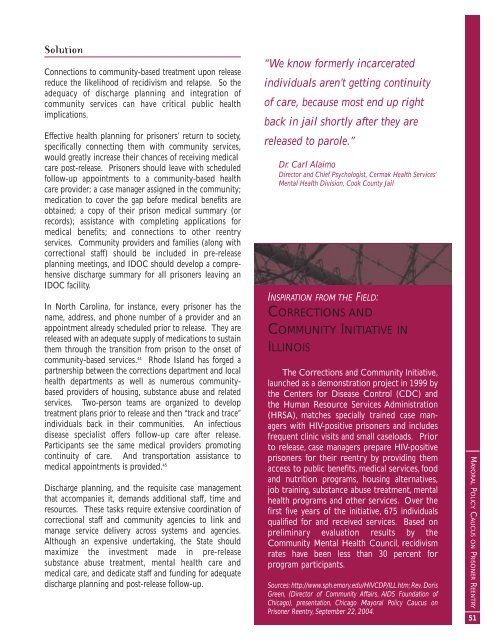Rebuilding Lives. Strengthening Communities.
Rebuilding Lives. Strengthening Communities.
Rebuilding Lives. Strengthening Communities.
Create successful ePaper yourself
Turn your PDF publications into a flip-book with our unique Google optimized e-Paper software.
Solution<br />
Connections to community-based treatment upon release<br />
reduce the likelihood of recidivism and relapse. So the<br />
adequacy of discharge planning and integration of<br />
community services can have critical public health<br />
implications.<br />
Effective health planning for prisoners’ return to society,<br />
specifically connecting them with community services,<br />
would greatly increase their chances of receiving medical<br />
care post-release. Prisoners should leave with scheduled<br />
follow-up appointments to a community-based health<br />
care provider; a case manager assigned in the community;<br />
medication to cover the gap before medical benefits are<br />
obtained; a copy of their prison medical summary (or<br />
records); assistance with completing applications for<br />
medical benefits; and connections to other reentry<br />
services. Community providers and families (along with<br />
correctional staff) should be included in pre-release<br />
planning meetings, and IDOC should develop a comprehensive<br />
discharge summary for all prisoners leaving an<br />
IDOC facility.<br />
In North Carolina, for instance, every prisoner has the<br />
name, address, and phone number of a provider and an<br />
appointment already scheduled prior to release. They are<br />
released with an adequate supply of medications to sustain<br />
them through the transition from prison to the onset of<br />
community-based services. 44 Rhode Island has forged a<br />
partnership between the corrections department and local<br />
health departments as well as numerous communitybased<br />
providers of housing, substance abuse and related<br />
services. Two-person teams are organized to develop<br />
treatment plans prior to release and then “track and trace”<br />
individuals back in their communities. An infectious<br />
disease specialist offers follow-up care after release.<br />
Participants see the same medical providers promoting<br />
continuity of care. And transportation assistance to<br />
medical appointments is provided. 45<br />
Discharge planning, and the requisite case management<br />
that accompanies it, demands additional staff, time and<br />
resources. These tasks require extensive coordination of<br />
correctional staff and community agencies to link and<br />
manage service delivery across systems and agencies.<br />
Although an expensive undertaking, the State should<br />
maximize the investment made in pre-release<br />
substance abuse treatment, mental health care and<br />
medical care, and dedicate staff and funding for adequate<br />
discharge planning and post-release follow-up.<br />
“We know formerly incarcerated<br />
individuals aren’t getting continuity<br />
of care, because most end up right<br />
back in jail shortly after they are<br />
released to parole.”<br />
Dr. Carl Alaimo<br />
Director and Chief Psychologist, Cermak Health Services’<br />
Mental Health Division, Cook County Jail<br />
INSPIRATION FROM THE FIELD:<br />
CORRECTIONS AND<br />
COMMUNITY INITIATIVE IN<br />
ILLINOIS<br />
The Corrections and Community Initiative,<br />
launched as a demonstration project in 1999 by<br />
the Centers for Disease Control (CDC) and<br />
the Human Resource Services Administration<br />
(HRSA), matches specially trained case managers<br />
with HIV-positive prisoners and includes<br />
frequent clinic visits and small caseloads. Prior<br />
to release, case managers prepare HIV-positive<br />
prisoners for their reentry by providing them<br />
access to public benefits, medical services, food<br />
and nutrition programs, housing alternatives,<br />
job training, substance abuse treatment, mental<br />
health programs and other services. Over the<br />
first five years of the initiative, 675 individuals<br />
qualified for and received services. Based on<br />
preliminary evaluation results by the<br />
Community Mental Health Council, recidivism<br />
rates have been less than 30 percent for<br />
program participants.<br />
Sources: http://www.sph.emory.edu/HIVCDP/ILL.htm; Rev. Doris<br />
Green, (Director of Community Affairs, AIDS Foundation of<br />
Chicago), presentation, Chicago Mayoral Policy Caucus on<br />
Prisoner Reentry, September 22, 2004.<br />
MAYORAL POLICY CAUCUS ON PRISONER REENTRY<br />
51
















